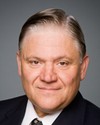Thank you, Mr. Chair.
If you can give me a nod when there is one minute remaining, I would appreciate it.
I'm here today to object to the latest federal electoral boundaries that the commission has proposed, which would mean that those parts of the riding of Scarborough—Agincourt south of Finch Avenue and west of the CN tracks, parallel to Midland Avenue, would be removed and assigned to a new riding south of the 401. This is shown on map 2, which we'll be distributing to you.
Over the past weeks I have communicated these changes with my constituents by letter and by automatic voice drop. I also held a town hall meeting in the area most affected. In response I have received over 700 e-mails, 448 voice responses, and 300 questionnaire responses. Approximately 100 people attended the town hall meeting.
Mr. Chair, as a matter of fact, we were communicating some of that to your clerk, and your clerk said, “Enough, we don't want...”. However, for the committee, we've brought it along and we'll leave it with you.
The overwhelming response was not in favour of the commission's proposed changes. In fact, Mr. Chair, we received responses from seven people who supported the proposed changes. I have also received letters opposing the significant changes to the riding of Scarborough—Agincourt from the provincial members of Parliament, the City of Toronto councillors, and the school board trustees—all of them—who will be affected by these changes. This proposal has not been received with much enthusiasm in Scarborough—Agincourt. In fact, many have asked me why these radical changes are being made. The proposed changes to the riding boundaries present three major issues:
One, the abandonment of Highway 401 as a boundary between communities of differing interests.
Reference is made in the commission's report to where the highway can or should be breached. The response of many of my constituents is that Highway 401 is a major piece of infrastructure that forms the southern boundary of their community of Agincourt.
Two, the division through the very middle of north Scarborough's oldest community—Agincourt.
The Village of Agincourt was officially founded by John Hill with the establishment of the Agincourt Post Office, which opened in June 1858. Its original location was on Sheppard Avenue. The community also served north Scarborough's agricultural community. Agincourt's electoral voice has always been found in the Scarborough riding north of the 401. However, the commission's proposal aligns part of the Agincourt community with the community of Wexford, which is south of the 401. The links between these two communities are very weak. See map 2.
The commission's proposed boundary along the CN tracks divides present-day Agincourt's community institutions: the Agincourt Mall, the Agincourt library, and the Agincourt GO station, which are assigned to Scarborough—Wexford.
Three, the isolation of some 7,500 residents outside the riding's proposed eastern boundary in neighbouring Scarborough—Rouge.
The commission's proposed changes to the northeastern Scarborough—Agincourt boundary include McCowan Road, McNicoll Avenue, and Middlefield Road. By using McCowan Road in particular, the approximately 7,500 residents, who live east of Woodside Square, would be electorally isolated and situated with 95,000 constituents in communities far to the east on the other side of the CP marshalling yards in the proposed Scarborough—Rouge riding. See map 4.
The suggested boundary also severs school catchment zones, commercial areas, and residential communities. The effect of this new eastern boundary is to isolate voters. Isolation gives way to marginalization, and to be marginalized is to be less than engaged. The commission has heard no call in support of these changes from the residents east of Woodside Square and no call that they will be isolated from their immediate neighbours in the community.
Now to conclude, the effects of the commission's proposed changes are at odds with the lay of the land and communities of interest. It has been my intention to put on the record today the clearly negative community impacts that arise from the suggested new riding boundaries.
Thank you, Mr. Chair.

